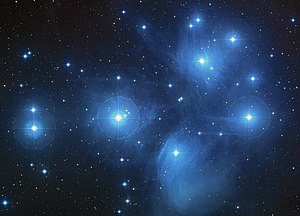Atlas (star)
Atlas /ˈætləs/,[9] designation 27 Tauri, is a triple star system in the constellation of Taurus. It is a member of the Pleiades, an open star cluster (M45). It is 431 light-years (132 parsecs) away,[7] and is 3.92 degrees north of the ecliptic.
 | |
| Observation data Epoch J2000 Equinox J2000 | |
|---|---|
| Constellation | Taurus |
| Right ascension | 03h 49m 09.74258s[1] |
| Declination | +24° 03′ 12.3003″[1] |
| Apparent magnitude (V) | 3.63[2] (3.84 / 5.46)[3] |
| Characteristics | |
| Spectral type | B8III[4] |
| U−B color index | -0.36[5] |
| B−V color index | -0.08[5] |
| Variable type | Suspected |
| Astrometry | |
| Radial velocity (Rv) | 8.5 ± 2[6] km/s |
| Proper motion (μ) | RA: 17.70[1] mas/yr Dec.: -44.18[1] mas/yr |
| Parallax (π) | 8.53 ± 0.39[1] mas |
| Distance | 431 ± 13 ly (132 ± 4[7] pc) |
| Orbit[7] | |
| Period (P) | 290.984 ± 0.079 d |
| Semi-major axis (a) | 13.08 ± 0.12 mas |
| Eccentricity (e) | 0.2385 ± 0.0063 |
| Inclination (i) | 107.87 ± 0.49° |
| Longitude of the node (Ω) | 154.0 ± 0.7° |
| Periastron epoch (T) | JD 2450583.0 ± 1.9 |
| Argument of periastron (ω) (secondary) | 151.9 ± 2.2° |
| Semi-amplitude (K1) (primary) | 26.55 ± 1.41 km/s |
| Semi-amplitude (K2) (secondary) | 36.89 ± 0.22 km/s |
| Details | |
| Atlas A | |
| Mass | 4.74 ± 0.25[7] M☉ |
| Radius | 2.0[8] R☉ |
| Surface gravity (log g) | 3.483 ± 0.113[4] cgs |
| Temperature | 13446 ± 218[4] K |
| Rotational velocity (v sin i) | 280[4] km/s |
| Atlas B | |
| Mass | 3.42 ± 0.25[7] M☉ |
| Other designations | |
| Database references | |
| SIMBAD | data |
Nomenclature
27 Tauri is the star's Flamsteed designation.
In 2016 the International Astronomical Union organized a Working Group on Star Names (WGSN)[10] to catalogue and standardize proper names for stars. The WGSN approved the name Atlas for this star on 21 August 2016 and it is now so entered in the IAU Catalog of Star Names.[11]
Mythology
Atlas was a Titan and the father of the Pleiades sisters in Greek mythology.
Properties
The primary component, Atlas A, is a blue-white B-type giant with an apparent magnitude of +3.62.[2] It is a binary star whose components have magnitudes of 3.84 and 5.46.[3] The binary makes one orbit every 290 days, and the eccentricity is about 0.24.[7]
See also
- Atlas (star) in fiction
References
- van Leeuwen, F.; et al. (2007). "Validation of the new Hipparcos reduction". Astronomy and Astrophysics. 474 (2): 653–664. arXiv:0708.1752. Bibcode:2007A&A...474..653V. doi:10.1051/0004-6361:20078357.
- Ducati, J. R. (2002). "VizieR Online Data Catalog: Catalogue of Stellar Photometry in Johnson's 11-color system". CDS/ADC Collection of Electronic Catalogues. 2237. Bibcode:2002yCat.2237....0D.
- "Sixth Catalog of Orbits of Visual Binary Stars". United States Naval Observatory. Retrieved 21 June 2017.
- David, Trevor J.; Hillenbrand, Lynne A. (2015). "The Ages of Early-Type Stars: Strömgren Photometric Methods Calibrated, Validated, Tested, and Applied to Hosts and Prospective Hosts of Directly Imaged Exoplanets". The Astrophysical Journal. 804 (2): 146. arXiv:1501.03154. Bibcode:2015ApJ...804..146D. doi:10.1088/0004-637X/804/2/146.
- Mermilliod, J.-C. (1986). "Compilation of Eggen's UBV data, transformed to UBV (unpublished)". Catalogue of Eggen's UBV Data. Bibcode:1986EgUBV........0M.
- Wilson, Ralph Elmer (1953). "General catalogue of stellar radial velocities". Washington. Bibcode:1953GCRV..C......0W.
- Zwahlen, N.; North, P.; Debernardi, Y.; Eyer, L.; Galland, F.; Groenewegen, M. A. T.; Hummel, C. A. (2004). "A purely geometric distance to the binary star Atlas, a member of the Pleiades". Astronomy & Astrophysics. 425 (3): L45. arXiv:astro-ph/0408430. Bibcode:2004A&A...425L..45Z. doi:10.1051/0004-6361:200400062.
- Pasinetti Fracassini, L. E.; et al. (2001). "Catalogue of Apparent Diameters and Absolute Radii of Stars (CADARS) - Third edition - Comments and statistics". Astronomy & Astrophysics. 367: 521–24. arXiv:astro-ph/0012289. Bibcode:2001A&A...367..521P. doi:10.1051/0004-6361:20000451.
- Kunitzsch, Paul; Smart, Tim (2006). A Dictionary of Modern star Names: A Short Guide to 254 Star Names and Their Derivations (2nd rev. ed.). Cambridge, Massachusetts: Sky Pub. ISBN 978-1-931559-44-7.
- IAU Working Group on Star Names (WGSN), International Astronomical Union, retrieved 22 May 2016.
- "IAU Catalog of Star Names". Retrieved 28 July 2016.